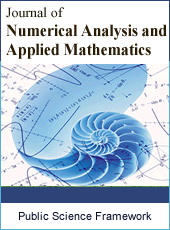Journal of Numerical Analysis and Applied Mathematics
Articles Information
Journal of Numerical Analysis and Applied Mathematics, Vol.1, No.1, Sep. 2016, Pub. Date: Aug. 5, 2016
Stochastic Mathematical Model of “Tunnelling” ― Penetration of Particle Through Prohibitive Barrier
Pages: 14-22 Views: 3697 Downloads: 631
[01]
Vladimir A. Dobrynskii, Institute for Metal Physics of N.A.S.U., Kiev, Ukraine.
In the article, properties of solutions to one specific kind stochastic ordinary differential equation system are examined. This system simulates the Brownian walks which active particles make along the -axis due to the permanent white noise action. In order to study the system solution properties, a number of snapshots of experimental 1-dimensional frequency distribution function that is build up on base of the found solutions is made. Watching these snapshots we find that there exists a parameter domain such that the system under study can serve as a mathematical model of process of tunnelling ― a penetration of elementary particle through a prohibitive potential barrier.
Active Particle, Vivacity, Natural Internal Frequency, Tunnel Effect, Penetration
[01]
Rěvěsz P. Random walk in random and non-random environments. World Scientific. Singapore, 1990.
[02]
Haken H. Synergetics. Springer. Berlin, 1983.
[03]
Haken H. Advanced synergetics. Springer. Berlin, 1985.
[04]
Zaslavsky G. M., Sagdeev R. Z., Usikov D. A. and Chernikov A. A. Weak chaos and quasi-regular patterns. Cambridge University Press, Cambridge, 1987.
[05]
Schuster H. G. Deterministic Chaos. Springer. 3rd edition. Berlin, 1995.
[06]
Karatzas I. and Shreve S. E. Brownian motion and stochastic calculus, Springer. 2nd edition. Berlin, 1996.
[07]
Vavrin D. M., Ryabov V. B., Sharapov S. A. and Ito H. M. Chaotic states of weakly and strongly nonlinear oscillators with quasiperiodic excitation. Phys. Rev E 53, 1996, pp. 103-114.
[08]
Doering Ch. R., Sargsyan Kh. V. and Smereka P. A numerical method for some stochastic differential equations with multiplicative noise. Physics Letter A, vol. 344, 2005, pp. 149-155.
[09]
Rossler A. Runge-Kutta methods for Ito stochastic differential equations with Scaler noise. BIT Numerical Mathematics, vol. 46, 2006, pp. 97-110.
[10]
Socha L. Linearization methods for stochastic dynamic systems, Springer, Berlin, 2008.
[11]
Archambear C. and Opper M. Approximation influence for continuous-time Markov processes. In: Baysesian Time Series Models, chapter 6, pp. 125-140, Cambridge University Press, Cambridge, 2011.
[12]
Sarkka S. and Sarmavuori J. Gaussian filtering and smoothing for continuous-Discrete dynamic systems. Signal Processing, vol. 93, 2013, 500-510.
[13]
Ivanov M. A, Dobrynskiy V. A. Random walk of oscillator on the plane with non-homogeneous friction. Int. INFA-ANS J. Problems Nonlinear Analysis in Engineering Systems”, vol. 12, no. 1(15), 2006, pp. 101-116.
[14]
Ivanov M. A, Dobrynskiy V. A. Stochastic dynamics of oscillator drift in media with spatially non-homogeneous friction, J. Automation and Information Sci., vol. 40., no. 7, 2008, pp. 9-25.
[15]
Dobrynskii V. A. Unusual frequency distribution function shape generated by particles making Brownian walk along line with monotone increasing friction, Int. J. of Mathematics and Computation Sci., vol. 1., no. 3, 2015, pp. 91-97.

ISSN Print: Pending
ISSN Online: Pending
Current Issue:
Vol. 2, Issue 2, March Submit a Manuscript Join Editorial Board Join Reviewer Team
ISSN Online: Pending
Current Issue:
Vol. 2, Issue 2, March Submit a Manuscript Join Editorial Board Join Reviewer Team
| About This Journal |
| All Issues |
| Open Access |
| Indexing |
| Payment Information |
| Author Guidelines |
| Review Process |
| Publication Ethics |
| Editorial Board |
| Peer Reviewers |


